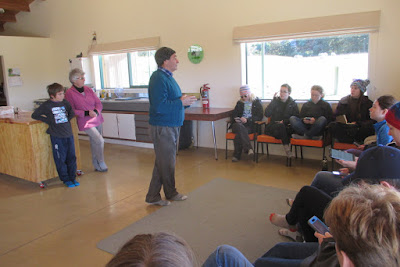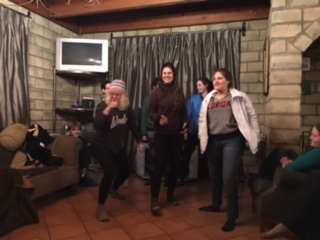Today we had a relatively late start at 9:30 a.m., when we piled into the Gator Waka for an early tea time at Coffee Culture in Lincoln. Once we were all suitably caffeinated/warmed with a hot drink, we resumed our journey to Washpen Falls. We stopped along the drive for a photo op and an impromptu irrigation lesson. Dr. Hostetler explained the evolution of irrigation systems from water races to pivots, informing us of the pros and cons of the newer pivot system, which, although more efficient, also encourages dairy farming in regions that would previously have been unsuitable to the dairy industry.
We arrived at the trail head for the Washpen Falls hike. The one-and-a-half-hour hike took us around two and a half hours because we stopped for lunch and because it was seriously windy, especially on the bluff. Along the private trail, we saw manuka, hounds tongue fern, kowhai, and bush lawyer, among others. Our observations weren't just limited to flora; we also saw quite a few bellbirds and a stray wood pigeon.
We came across numerous numbered trail markers which corresponded to numbers on the free trail pamphlets we were given at the information centre. These markers identified such sites as a volcanic boulder, a hand dug pond, and a cave site which was used to shelter Maori hunters as they hunted moa. We also passed an old military target practice site that dated back to the Second World War and was serviced by New Zealand's Home Guard – the rough equivalent of our own national guard. We were also reintroduced to sooty mold, honeydew, and the scale insects we first saw yesterday at Lords Bush Scenic Reserve.
After breaking for lunch at Stone Lake, we continued on to the end of the trail and then drove back to Lincoln, stopping for a second tea time at The Hororata Cafe along the way.
The photo op stop, where Dr. Hostetler explained past and present irrigation systems.
A trail marker; this one shows the Radiata Pine, an exotic wilding pine that fuels much of New Zealand's modern timber industry.
Erika holding up bush lawyer, a native bush with thorny hooks that snag the skin and never let go (hence the common name bush lawyer).
An example of high ropes, a team building exercise a step above the low ropes we performed at the beginning of the course
Douglas Fir forest – all exotic and all problematic, since the plant is shade tolerant and grows rampantly in New Zealand.
Group photo atop the lava boulder, which the pamphlet says is 89 million years old and was bared by glaciation during the Ice Age. (Not pictured, Ali. She is a little under the weather and resting in the Gatorwaka.)
The WWII target practice site – the target is still visible today because it was made by a lead-based paint.
View of Canterbury Plains from near the bluff. Note the prevalence of exotics from cliff to sea shore.
Lucy's Lagoon, situated beneath the Washpen Falls.
Stone Lake, where we stopped for lunch. The pamphlet informs us that the lake was manmade and created by Tom Stone in the early 1920s.
A humorous sign found near the end of the trail.
The Hororata Cafe, where we stopped for our second tea time of the day. The cafe takes its name from the nearby Hororata River, one of whose tributaries forms the Washpen Falls.
Erika and Tatiana enjoying their tea time with bonus wontons.
~ Anna



















































